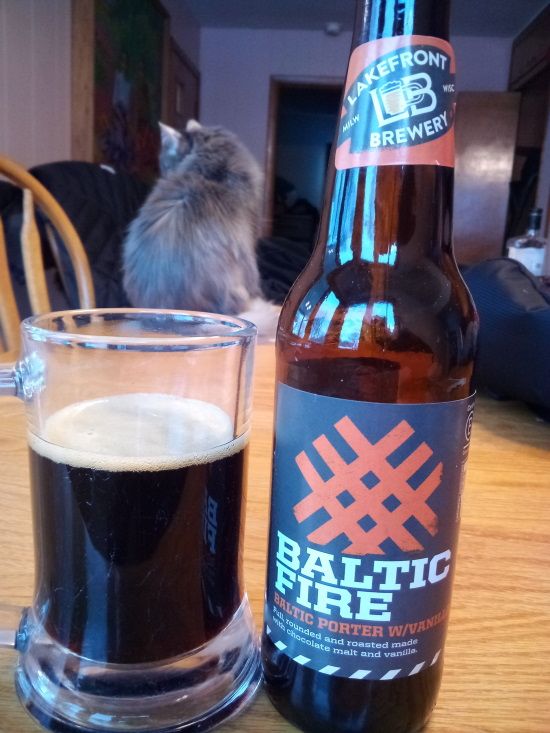Yesterday I wrote about the advent of coffee beer in 1994 just 25 miles to my south in New Glarus. And today I have read that the term "Baltic porter" was first used that very same year by Bill Yenne in his book Beers of the World although it was über beer geek Michael Jackson that seems to have popularized the term 4 years later. There truly was more to the 90's than grunge, cargo pants, despair, and indifference.
While Slavic food is severely underrepresented in the Madison dining scene today, a restaurant called Russia House spent much of the 1990s evoking images of Sean Connery romancing Michelle Pfeiffer and dishing out borscht and vodka to folks downtown. I was sad to see it go but was very happy to see the opening of Arbat Russian Restaurant in nearby Fitchburg sometime the following decade. I have fond memories of chasing away the winter chill there with hearty platefuls of pelmeni and stuffed pork loin. And to wash it all down I was able to choose from a full array of Baltika beers with my favorite being #6, their Baltic porter.
English beer historian Martyn Cornell has written about the history of this style so credit is due to him for what follows.
The short story is that the Poles developed a taste for English porter in the 18th century with a particular fondness for something called the "double brown stout" which sounds like it was a much, um, stouter porter than its more workaday cousin. I suppose it isn't surprising that the Poles had a taste for a stronger brew considering their hostile neighbors. You too would seek out a more potent potable if the Prussians, Russians and Austrians invaded your country and wiped it off of the map as happened in 1795 when the state of Poland was terminated and would not reappear for 120+ years.
Fast forward to the 19th century when lager brewing was all the rage and some entrepreneuring Polish brewers applied it to their beloved porters. And voila! The Baltic porter was born.
Until an international standards committee comes up with a mutually agreeable definition of what exactly constitutes a Baltic porter, I will continue to labor under the characterization of a beer that is a dark lager around 8% A.B.V. that is otherwise a porter.
It's a fairly uncommon style here in Madison, as far as I can tell. When I am at a liquor store in Chicago, the shelves have Baltic porters from various large Polish brands such as Okacim, Zywiec, and Perła in addition to Baltika, which is a Russian brewery. Unlike Chicago, Madison does not have a large Polish/Polish-American population and so those beers don't show up on our shelves. Thankfully some craft brewers are happy to help fill the gap. Last winter I tasted a Baltic porter from Milwaukee's Third Space Brewing called Ice Bear. And late last autumn another Milwaukee brewery, Lakefront, gave us Baltic Fire, a Baltic porter with vanilla.
Lakefront is one of the progenitors of the Wisconsin craft
beer industry having opened in 1987. Their Riverwest Stein is not only tasty,
but also a stalwart of the beer scene here. It's one of those brews that does a
yeoman's job in places that don't have menus that are printed in a typeface so
small you need a magnifying glass to read because they need to fit in all the
trendy IPAs and hard seltzers they serve on a single sheet.
While I am inclined favorably towards Lakefront, my Spidey senses tingled when I saw that their new Baltic porter was made with vanilla. Additives in beer can have some tasty results but American brewers tend to use them with all the subtlety of Donald Trump at a beauty pageant. So, I was a bit leery about this Baltic fire stuff yet I tried it anyway because a Baltic porter with vanilla sounds delicious.
Baltic Fire looked dark brown with a slight reddish tint. Its clarity allowed me to see lots of bubbles bopping around inside. My photo, as usual, doesn't capture the beer in all of its glory as the big tan head exited stage right hastily. As someone who enjoys dark beers, I can say she was a looker and had me chomping at the bit to take a sip. Taking a whiff, I caught vanilla. Lots of it. "This must be what it's like working at the McCormick vanilla extract factory," I thought to myself. Subsequent sniffs revealed some stone fruit and coffee smells.
My first sips revealed a good fizziness – recall all of those bubbles – and a medium bodied dark lager with a hint of coffee and a large dose of vanilla. As in, had I just fallen into a vanilla extract vat at that McCormick factory? Heavens to Murgatroyd, that was some potent vanilla! Not surprisingly, that taste lingered after I swallowed though a little fruitiness emerged along with a hint of dark chocolate. Then I tasted some hoppy bitterness and a rather unpleasant extracty astringency.
Sadly, my additive-induced wariness proved correct. This
beer was not for me. The vanilla was just too much and suffocated the wonderful
porter flavors. Those coffee and chocolate bits need to breathe! I hope that Lakefront
tries again and uses a lighter touch when it comes to the vanilla because I think
there are some complementary flavors here that are simply out of balance.
Junk food pairing: Pair Baltic Fire with something that will replace some of the lost porter flavors. Go with a bowl of Brownie Supreme Chex Mix Muddy Buddies.


No comments:
Post a Comment